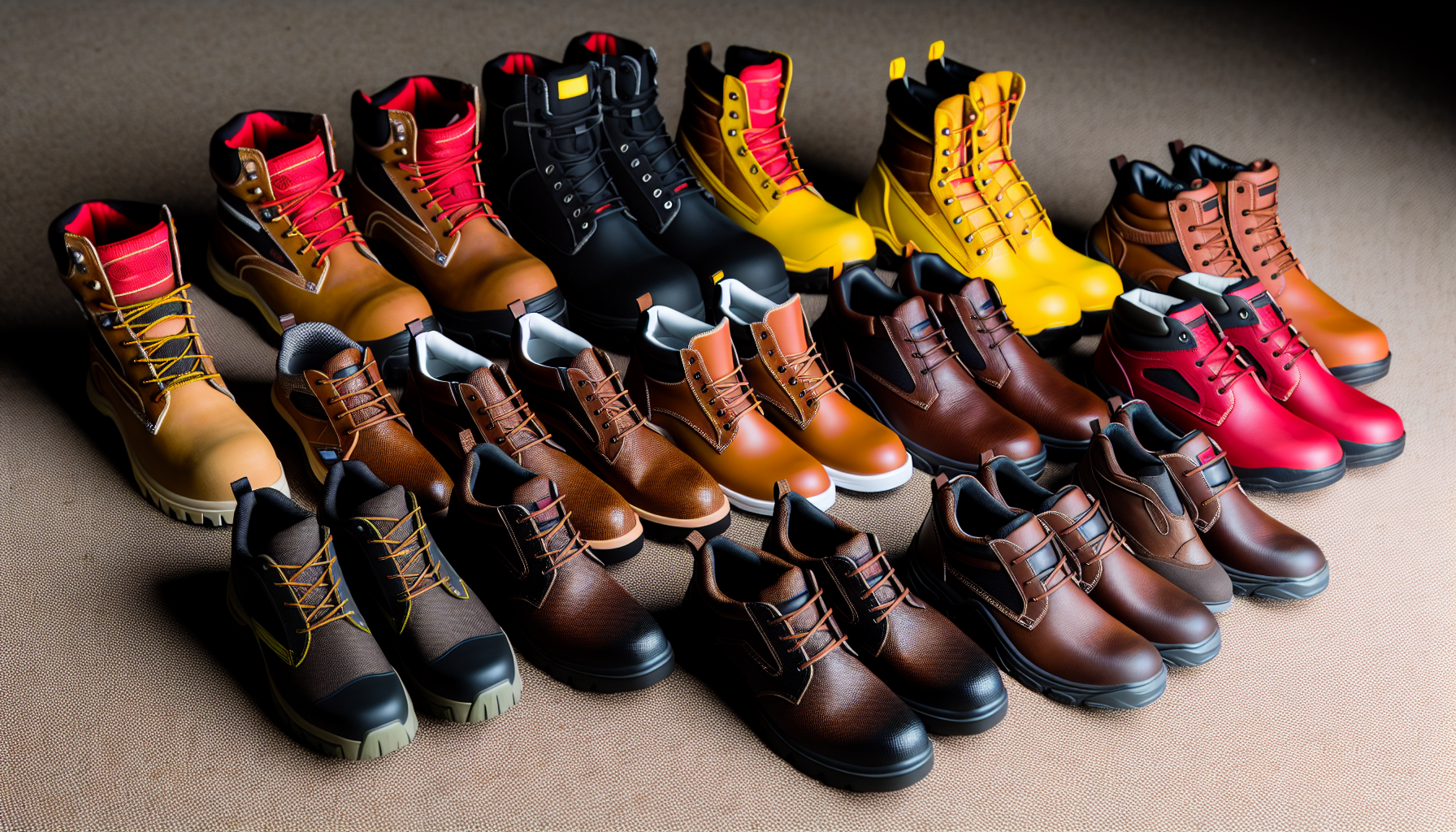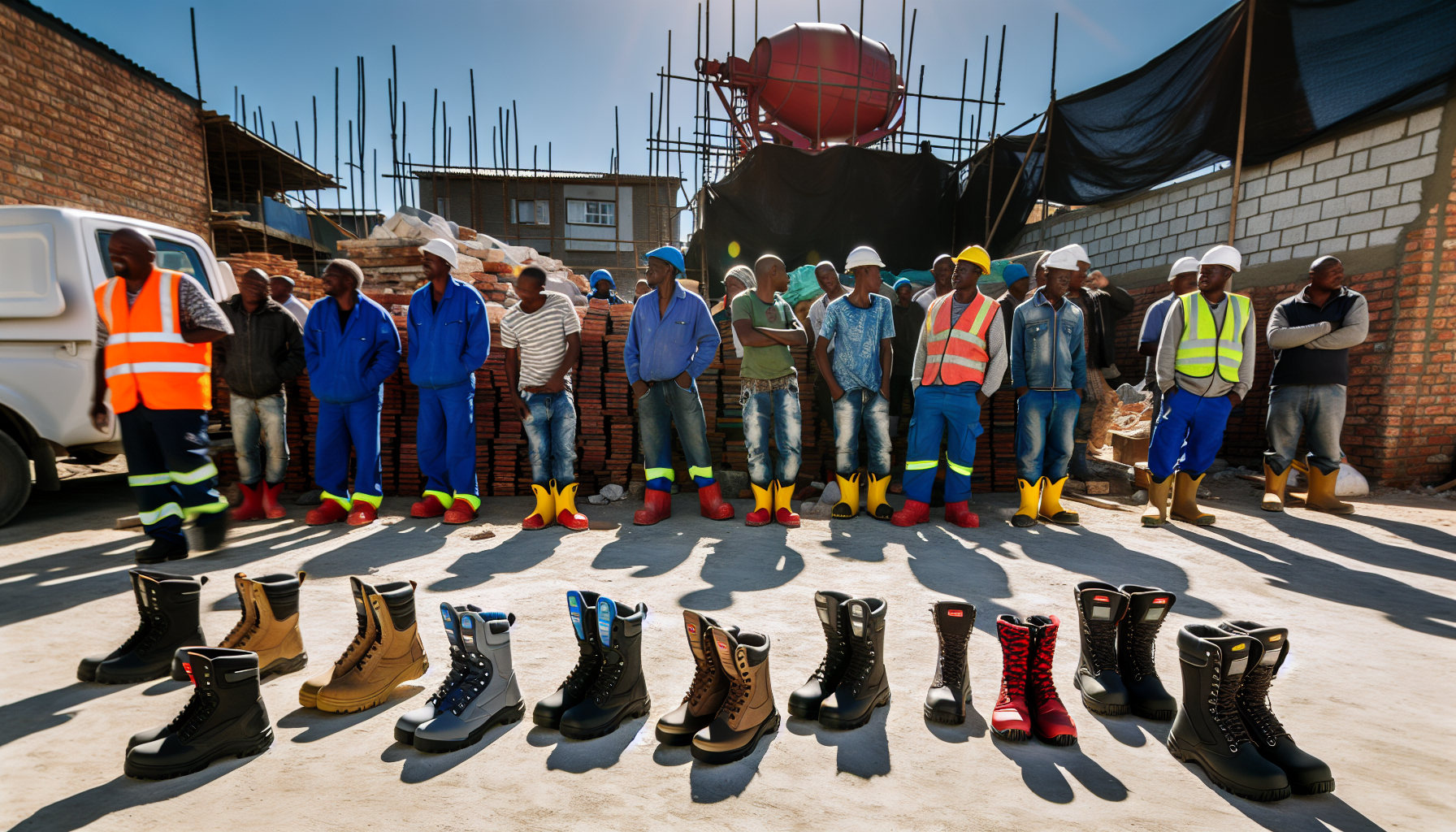Looking for safety shoes in South Africa that tick all the boxes for regulations, comfort, and durability? Our straightforward guide on “Safety Shoes South Africa” distills the essentials, providing you with top considerations for footwear that won’t let you down in your work environment.
Key Takeaways
-
Safety shoes in South Africa are essential for worker protection across various industries, manufactured in ISO accredited facilities to ensure quality and adherence to safety standards with specific focus on inclusivity and gender-specific designs, such as women’s safety footwear by Sisi.
-
Engineering advancements, notably 3D printing and scanning, play a crucial role in the safety footwear industry, allowing for custom-designed shoes that are tailored to specific workplace hazards and individual fit, enhancing both protection and comfort.
-
In South Africa, employers are legally obliged to provide safety footwear compliant with national and international standards like ISO 20345, with additional certifications for specialized risks, enhanced by support services to ensure ongoing compliance and high safety quality.
Exploring the Landscape of Safety Shoes in South Africa

In South Africa, safety footwear goes beyond accessory status; it plays a critical role in providing worker protection, support, and comfort across diverse industries. The safety shoes are produced in ISO accredited facilities, ensuring consistent quality and adherence to safety standards. This confidence in quality ensures that workers remain protected, while employers gain the peace of mind that comes from knowing that their workforce is well-protected.
One notable company in South Africa’s safety footwear sector is Sisi. For over 15 years, Sisi has carved a niche in the safety footwear market by focusing on women-specific Personal Protective Equipment (PPE). Recognizing that women have been largely overlooked in the industry, Sisi has shifted the narrative by providing a range of safety footwear designed to meet the specific needs and anatomy of women.
This focus on gender-specific safety footwear is a testament to the industry’s commitment to inclusivity and diversity. It also highlights the adaptability of the safety footwear industry in South Africa, which is constantly evolving to meet the varied needs of its diverse workforce.
South Africa’s safety footwear landscape is characterized by innovation, inclusivity, and a dedication to safety. With a wide range of products available for various industries, South African workers can be assured of both protection and comfort in their workplace.
The Engineer's Approach to Safety Boots
Engineering plays a pivotal role in the design and manufacturing of safety footwear. For instance, the advent of 3D printing technology has revolutionized safety footwear manufacturing. This technology facilitates the rapid customization of models at reduced costs, making it possible to design safety footwear that meets specific needs and hazards.
Leveraging 3D scanners to collect data on physical items has facilitated precision engineering in safety footwear. These scanners create accurate digital models for design analysis, ensuring that each pair of safety boots not only offers maximum protection but also fits perfectly.
In engineering, safety footwear is designed with features that protect feet from common hazards like heavy objects. For instance, industrial safety footwear must have anti-slip properties to prevent accidents on smooth and oily surfaces. Similarly, welding shop safety shoes are engineered to be heat resistant or anti-static to cushion against the risks from extreme temperatures and electrostatic discharges.
The selection process for safety footwear also considers whether low shoes or high shoes are necessary in relation to the protection required for the job. This careful consideration ensures that each worker gets the right kind of safety footwear best suited to their specific work environment and role.
Companies like Bova have committed themselves to crafting high-quality safety footwear over the years. Their commitment to protection and quality is evident in their expanded range of products, which now includes body, thermal, and fall protection gear.
Style Meets Safety: The Aesthetic Aspect of Safety Footwear

In the modern era, safety footwear extends beyond mere protection. Modern safety footwear in South Africa is designed to meet safety standards while also being fashionable. From formal designs to sneaker-styled designs, the range of styles available caters to diverse aesthetic preferences.
The evolution of safety boots beyond their traditional aesthetic is a testament to the industry’s commitment to meeting the needs of the modern worker. Safety footwear now comes in various colors and designs, allowing workers to express their personal style without compromising on safety.
For instance, mens safety footwear showcases a broad spectrum of styles, skillfully balancing aesthetics, comfort, and safety. Whether it’s a pair of rugged boots for the construction site or sleek, formal safety shoes for the office, there’s something for every man.
The aesthetic appeal of safety footwear extends beyond being a mere fashion statement. It’s also about boosting the confidence of workers. When workers feel good about what they’re wearing, they are more likely to be productive and engaged in their work.
In essence, the modern aesthetic of safety footwear in South Africa is a perfect blend of style and safety. It’s proof that you don’t have to sacrifice your sense of style for protection at work.
The Foundation of Support: Understanding Safety Footwear Technologies
The evolution of safety footwear technology aims for a balance between durability, comfort, and performance. Companies invest in research and development to enhance the development of safety footwear. One such collaboration is with Dr. Anette Thompson, a research podiatrist, who works closely with manufacturers to develop safety footwear based on research into South African foot shapes and health.
Safety footwear must comply with standards outlining vital protection features like midsole penetration resistance, water resistance, and electric shock protection. The selection of materials for safety shoes, including leather or fabric, directly influences the waterproofness and weight of the shoe.
Additionally, the toe cap material affects comfort and may require size adjustments for protective socks. The careful selection of materials and adherence to protection standards ensures that safety footwear provides optimal support and protection.
The adoption of cutting-edge technologies such as 3D printing and scanning has transformed the industry. These technologies enhance customization options and allow for quicker prototyping of new safety footwear designs. Moreover, 3D scanning aids in creating accurate digital models of safety shoes, facilitating design alterations and tailored customization according to client needs.
In essence, the cornerstone of safety footwear’s support hinges on a mix of research, technological innovation, and compliance with safety standards. This blend ensures that safety footwear offers the best in terms of durability, comfort, and performance.
Navigating Safety Footwear Regulations in South Africa
As per South Africa’s Occupational Health and Safety Act, employers are required to furnish employees with safety equipment, encompassing protective footwear, to avert injuries. Safety footwear must meet specific safety standards, like ISO 20345 for safety footwear, to be sold as ‘protective’ in South Africa, ensuring adequate protection for wearers.
Additional safety footwear standards cover specialized risks and include EN ISO 20346 for protective footwear, EN ISO 20347 for occupational footwear, and others for thermal risks, chemicals, and electrical insulation. Manufacturers must obtain certification from a Notified Body and affix the CE mark on safety footwear, signifying that the product has met the applicable European PPE standards.
Services like SGS provide the following services for safety footwear in South Africa:
-
Testing
-
Assistance with technical files
-
Coordination for EC type examination
-
Annual audits for Article 11 certification
These services ensure compliance and the highest standards of quality and safety for safety footwear.
Summary
In summary, safety footwear in South Africa is an essential part of the work environment, providing protection, support, and comfort to workers across various industries. The industry has evolved to incorporate style, with modern safety footwear offering diverse aesthetic choices without compromising on protection. The role of engineering and technology in enhancing the development of safety footwear is commendable. With rigorous safety footwear regulations in place, South Africa ensures the highest standards of quality and safety in its footwear. The future of safety footwear looks even brighter, with continuous advancements in technology and a commitment to meeting diverse needs.
